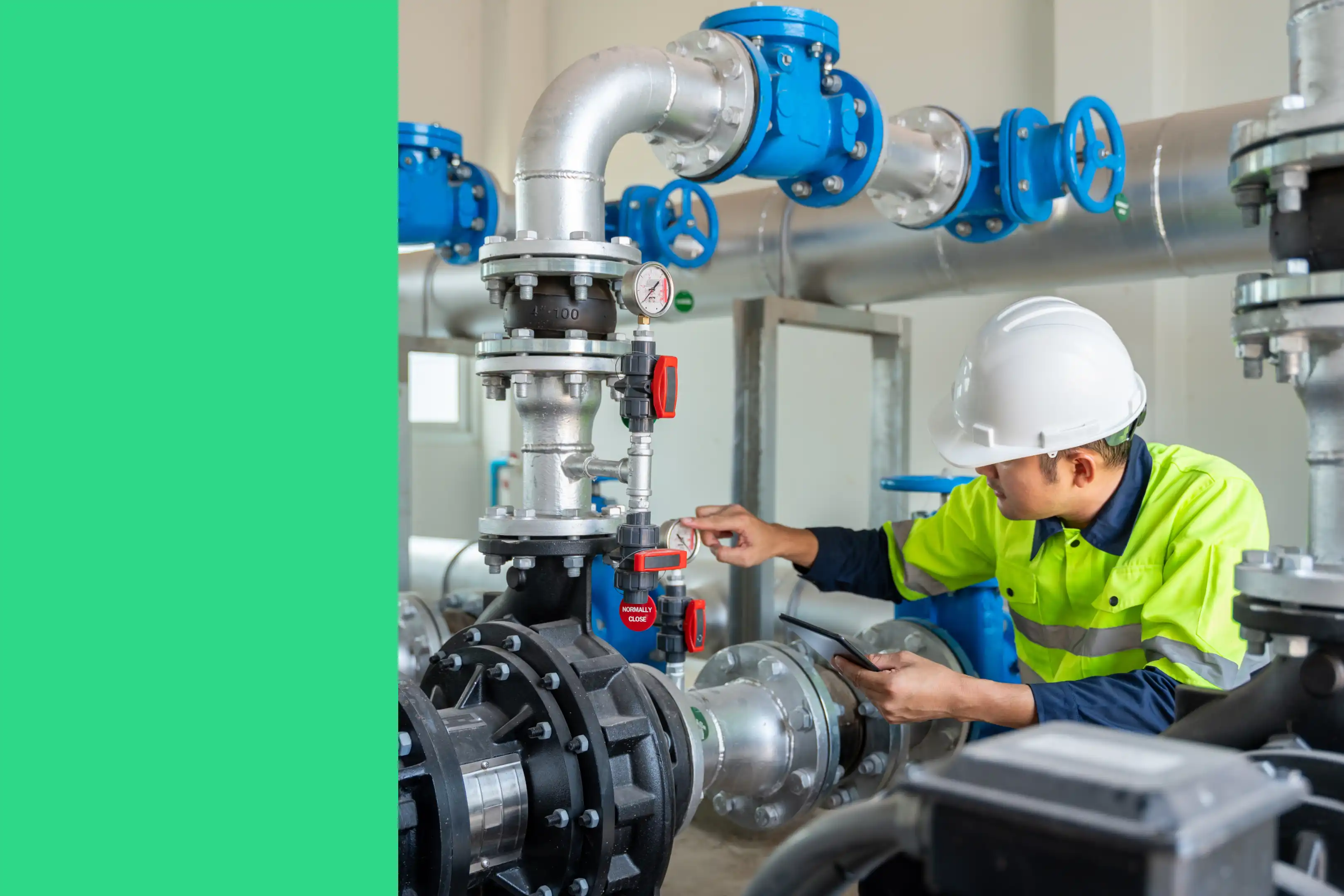
Have you ever avoided a restaurant because of a bad review? In many cases, reputation is the most crucial factor for people deciding whether to try a new restaurant, and the poor-quality dishes and lousy customer service that lead to a bad reputation don’t just happen—they are often the result of several crucial missteps in the operations process. This is where restaurant standard operating procedures (SOPs) come in. They help ensure that restaurant teams follow established steps to maintain the high food and service standards that keep customers happy.
What’s more, restaurant SOPs are also vital for compliance with regulatory requirements. The last thing a restaurant wants after working hard to keep customers happy is to face penalties—or even a shutdown—due to failed inspections. In this post, we explore different types of restaurant SOPs, how to create them, and the benefits of standardization.
What are restaurant standard operating procedures (SOPs)?
Restaurant standard operating procedures (SOPs) are written lists of rules, standards, and norms that describe how to complete routine tasks. Well-structured SOPs are important because they ensure both front-of-house and back-of-house workers know exactly how to satisfy work requirements safely, efficiently, and professionally.
Restaurants are required to maintain SOPs
Apart from ensuring customer satisfaction, restaurant SOPs also help establishments comply with legal requirements—restaurants are required by law to maintain written procedures for safe food handling. Effective SOPs translate both local health department and FDA regulations into daily protocols that keep everyone safe. Plans should outline processes for safety procedure monitoring, verifying, record-keeping, and taking corrective actions (when needed).
To maintain effective regulatory adherence, management should:
- Follow Food and Drug Administration (FDA) guidance: The FDA’s hazard analysis and critical control point (HACCP) training and monitoring principles address employee training, record keeping, quality improvement, and food safety training.
- Follow local health department food laws: SOPs should cover heating, cooling, labeling, handwashing, and other practices that prevent food-borne illnesses. Implement these processes and document their adherence to pass inspections with flying colors.
- Post OSHA and food regulation signage: These actions are necessary for teams to pass compliance inspections and receive the illustrious Grade A sign that encourages both customers and potential employees to come inside.
- Regularly review food-handling SOPs: Human beings are forgetful creatures, which means it’s important to regularly review safety SOPs with employees. Health inspectors may test their knowledge during routine health inspections.
What restaurants use SOPs for
Let’s take a closer look at how restaurants apply SOPs to keep customers happy, stay in regulatory compliance, and more.
Maintaining regulatory compliance
Keeping track of local food and health laws on a day-to-day basis can be challenging, especially with other tasks to complete. By developing SOPs based on these laws and regulations, you can ensure your facility complies with regulatory requirements by assigning work orders based on the procedures. With SOP checklists, teams have an easier time performing self-audits and identifying opportunities for process improvements. In addition, they can prove precautionary meal preparation, cleanliness, customer service, and facility maintenance to regulators.
Streamlining employee onboarding
SOPs make employee training programs more accessible, enjoyable, and convenient. You won’t need to rack your brain to remember dozens of minute details involved in diverse processes like POS data entry, cocktail curation, and bathroom sterilization. Instead, refer new hires to documented work instructions that leave no room for misinterpretation or oversights. Restaurant SOPs also ensure that tactical knowledge isn’t lost whenever staff members leave their jobs. Management can lean on the documents for both training new team members and cross-training when short-staffed.
Improving worker communication
With ever-changing regulatory guidelines, standardizing real-time communication channels is very important. SOPs, particularly digital SOPs, make it easier for leadership to stay in contact with workers throughout the day and share relevant updates. Using a computerized maintenance management system (CMMS) with real-time functionality for SOP updates means you can automatically share any new steps in your SOPs with your staff through their devices. You’ll eliminate confusion over updated protocols since workers can contact supervisors by sending an instant message on the app.
Enhancing customer service fulfillment
Good SOP enforcement helps standardize services across the board. Regardless of the size of your establishment, your aim should be to deliver a five-star experience. Patrons know what to expect every time they visit the restaurant, place an order, eat a meal, interact with employees, and so on. Positive predictability keeps customers returning.
Establishing recurring operational tasks
Additionally, documentation enables management to recall the numerous operational procedures integral to running food services. Optimize recurring processes for operational tasks—ordering supplies, scheduling preventive maintenance, conducting safety audits—to ensure they are completed in the same manner every time. Standardization provides peace of mind that essential task details get completed without error.
Ensuring cleanliness and personal hygiene
Finally, nothing is more important to restaurant operations than cleanliness. Preparing food for others necessitates proper sanitation at all times to reduce the risk of foodborne illnesses. Front-of-house workers should know exactly how to wipe down counters, sterilize utensils, and wash hands. Back-of-house workers also must know crucial food preparation precautions. Importantly, all employees should exercise excellent personal hygiene.
Next, we’ll explore the types of restaurant processes worth documenting.
Types of restaurant SOPs
Restaurant managers should document step-by-step instructions for the following types of routine procedures:
1. Facility and equipment maintenance SOPs
Facility and equipment SOPs establish how to handle and maintain the restaurant’s physical assets properly. They cover:
- Laundry and linen use
- Dining area sanitation
- Thermometer calibration
- Ice machine cleaning
- Pest control
- Dishwashing
- Equipment cleaning and sanitizing
- Equipment maintenance
2. Health and safety SOPs
This category of SOPs ensures that employees follow good health and safety practices to protect themselves, the food, and their customers. They cover:
- Handwashing practices
- Employee health and personal hygiene
- Use of utensils and gloves
- Emergency procedures
3. Compliance and legal SOPs
These procedures guide adherence to regulations. They include step-by-step guides covering:
- Inspections
- Documentation
- Reporting
4. Food flow SOPs
Food-flow SOPs contain detailed, written instructions to ensure the safe and consistent handling of foods. Examples include:
- Food preparation and handling
- Holding and reheating food temperatures
- Take-out and delivery standards
- Refrigerator and freezer maintenance
- Food storage
- Purchase and handling food from outside sources
- Recycling and composting food waste
5. Menu production SOPs
Menu-production SOPs ensure managers create menus that align with the restaurant’s concept, customer expectations, and business goals. They also deal with the following:
- Food presentation
- Order taking and serving
- Food donations
6. Training and development SOPs
These SOPs ensure proper training and development of existing staff along with the onboarding of new employees. They cover:
- Employee training
- Performance evaluation
7. Service and communication SOPs
Communication SOPs help ensure dialogue between restaurant management, staff, and customers. Communication SOPs usually cover:
- Customer service standards
- Order-taking and delivery
- Front-of-the-house greeting and seating
- Billing and final settlement
- Food safety regulations
- Staff orientation and training
- Engagement with kitchen visitors
- Communication of restaurant safety measures
- Response to food-borne illness complaints and reports
8. Inventory and stock management SOPs
These procedures help to ensure restaurants maintain adequate and properly managed stock levels. They cover:
- Inventory monitoring
- Storage
- Delivery handling
- Purchase ordering
- Vendor communication
10 Restaurant SOP templates
As mentioned, digital tools are a great way to create and manage your SOPs. A computerized maintenance management system (CMMS) like MaintainX allows you to create and assign work orders with digital SOPs. MaintainX houses a procedure library with templates that you can access, download, and modify to create your own tailored procedures. In addition, MaintainX’s Procedure Generator allows you to use AI to create your own procedures by simply supplying a few key details. Here are a few restaurant SOP templates from the MaintainX library.
- Pre-operational inspection SOPs for restaurants ready for inspection.
- Restaurant cleaning SOPs for the front and back of the house.
- Kitchen opening SOPs to ensure your kitchen is ready to operate.
- Kitchen closing SOPs to ensure your kitchen is prepared for closing.
- Sanitation SOPs to ensure your food manufacturing equipment is always clean.
- Food safety SOPs to ensure you are prepared for food safety inspections.
- Health approval SOPs to identify workplace hazards that require corrective actions.
- Service resources SOPs to facilitate preventive maintenance of commercial equipment.
- Back-of-house cleaning SOPs for proper sanitation of areas where food is prepared.
- Technology travel path SOPs for proper maintenance of front counters and registers.
How to create SOPs for your restaurant
MaintainX’s free restaurant SOP template is a great place to start when creating your own SOPs.
Here’s a guide to using the template.
Fill out the title page
Your title page should include relevant elements like the procedure title, the name of the organization or department using it, and the SOP’s purpose. As this particular template is editable, feel free to add or remove any details according to your needs. Bear in mind, however, that providing enough information on the title page is necessary for the proper classification of your SOPs.
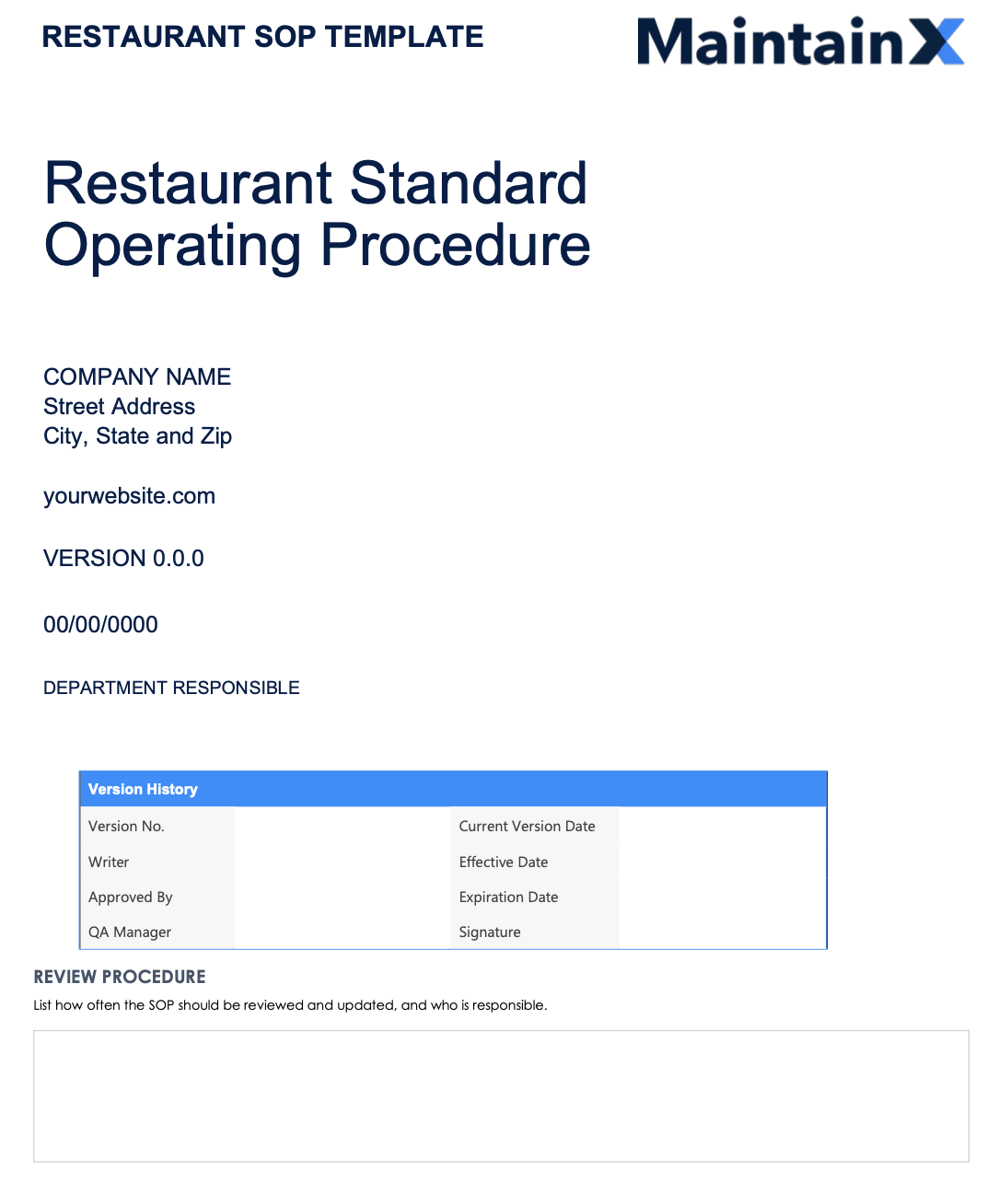
Define your review process, purpose, and scope
Next, decide and detail how often you want your SOP to be reviewed and who should be responsible for that. This helps ensure that the SOP itself is a self-contained document that is easy to update. In addition, provide some information about the purpose of your SOP and define the SOP’s scope.
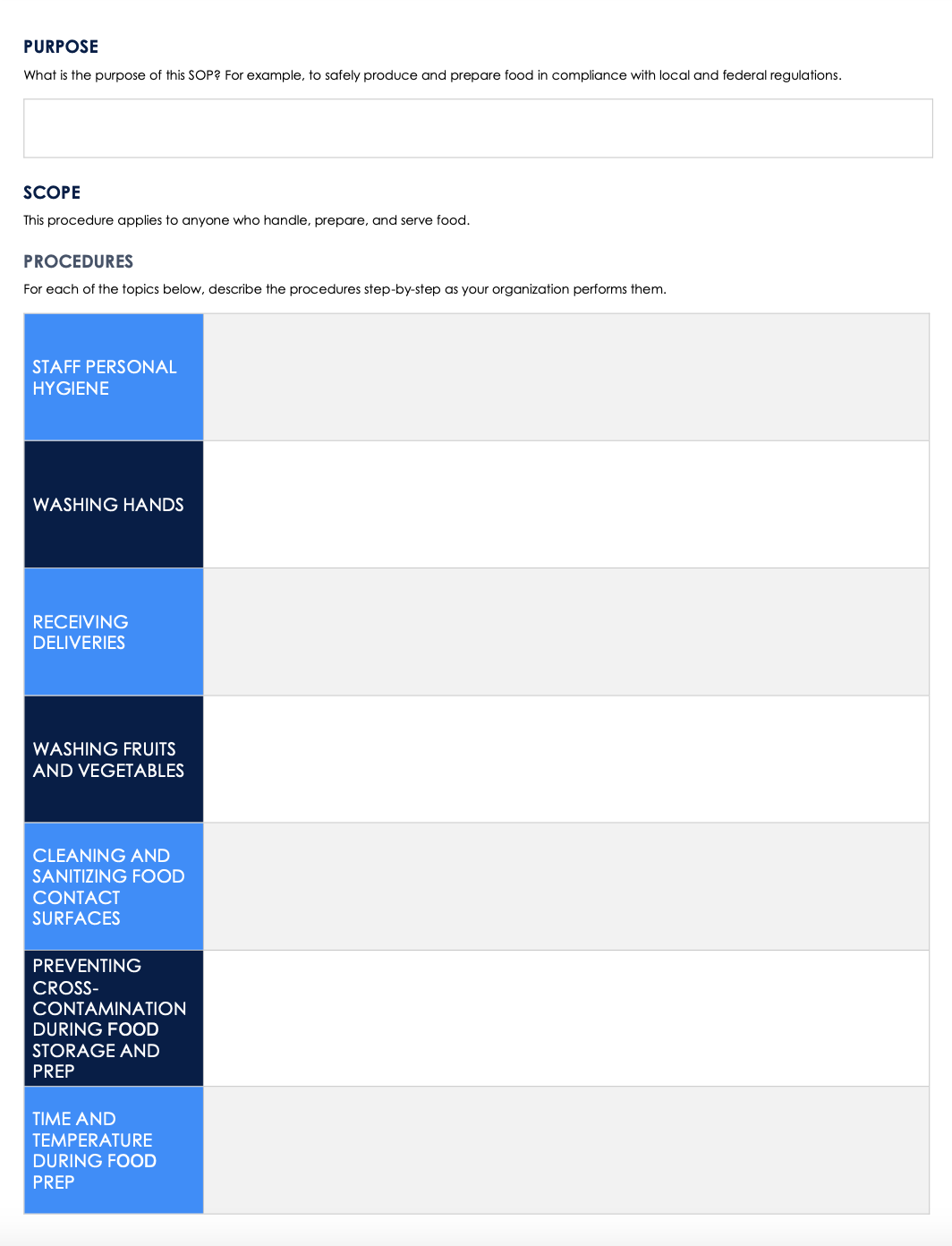
Write out the SOP
Before documenting SOPs, consult with the workers involved in the specific processes to ensure realistic outcomes. Often, employees can draw attention to problematic aspects of procedural plans that management can address to avoid confusion.

When writing SOPs, be straightforward. Avoid using unfamiliar terminology, writing lengthy paragraphs, and cluttering checklists with extraneous information.
Mobile SOP software providers like MaintainX streamline this process with PDF and photo attachments.
Finally, focus on how you want customers to perceive the business. Put yourself in your patrons’ shoes to write more comprehensive procedures that lead to rave online reviews, word-of-mouth referrals, and repeat business.
Read 8 Tips for Developing Standard Operating Procedures (That Get Used)
Rake in the positive reviews with MaintainX
Ready to take your restaurant operations to the next level? Take advantage of MaintainX’s intuitive features to plan and execute your maintenance, and see why one McDonald’s franchise owner reduced equipment downtime by 85% with MaintainX. Use MaintainX to:
Create maintenance checklists
Ensure that maintenance staff have detailed instructions for carrying out maintenance work and never miss a step. Instead of leaving staff trying to figure out how to handle maintenance tasks when the time arrives, if you give them an SOP with a checklist, you’ll empower them to go about their duties with confidence and certainty.

Establish automated escalation procedures
Instead of waiting for an issue to happen before you figure out what to do, you can create automated protocols for handling escalations. With MaintainX, you can trigger corrective actions automatically when something goes wrong and save critical time.
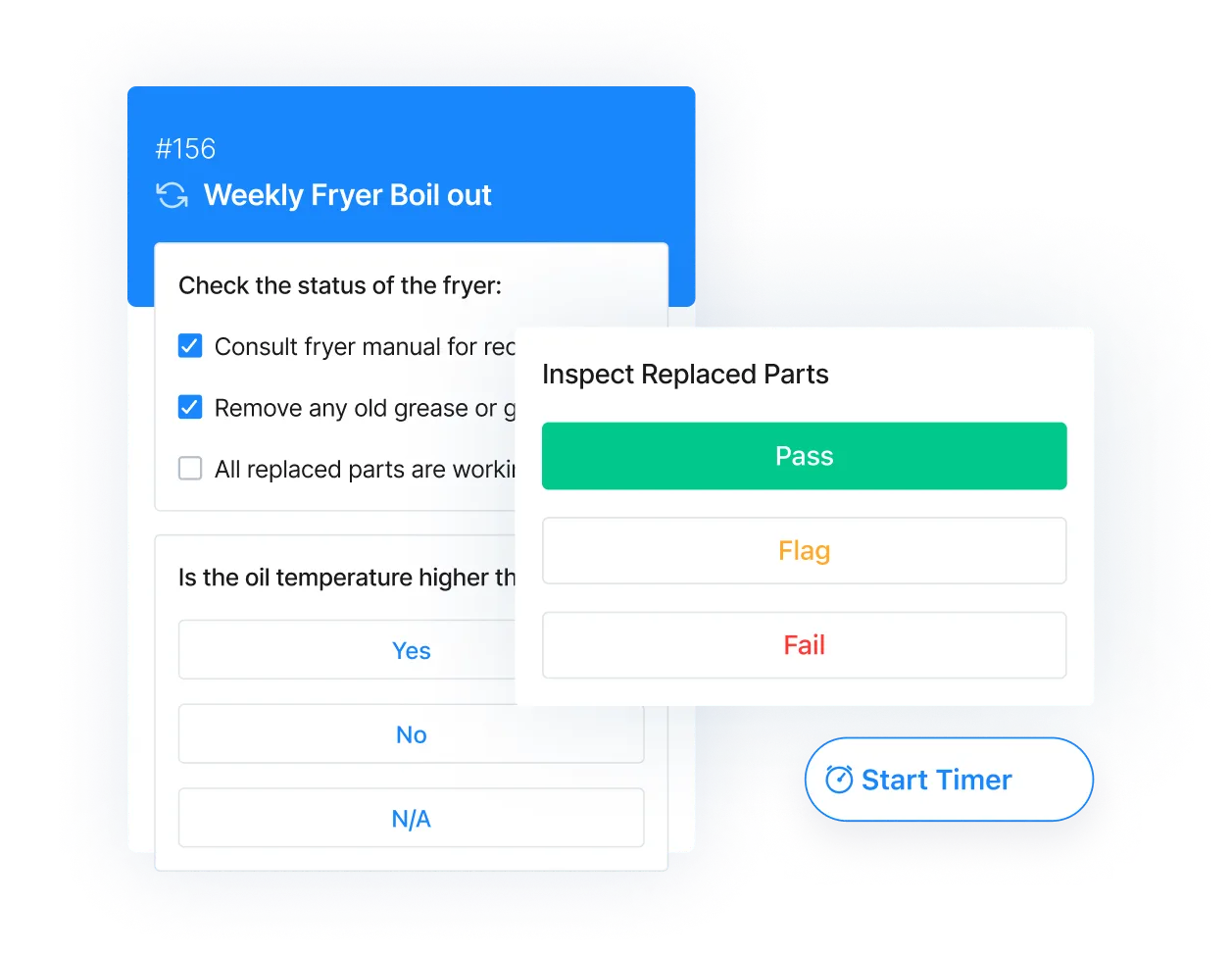
Track maintenance work from start to finish
Create, assign, and monitor maintenance work orders from beginning to end, all in one place. The last thing you want is for staff to spend time performing maintenance work wrongly when a simple note of clarification would have saved their time and energy. Get real-time updates from technicians and share feedback when necessary to ensure everyone is on the same page.

Capture more relevant data and facilitate collaboration
Keep everyone on the same page with MaintainX’s collaboration tools. With real-time chat, work order commenting, and photo and voice clip sharing, you can make sure no important details slip through the cracks.
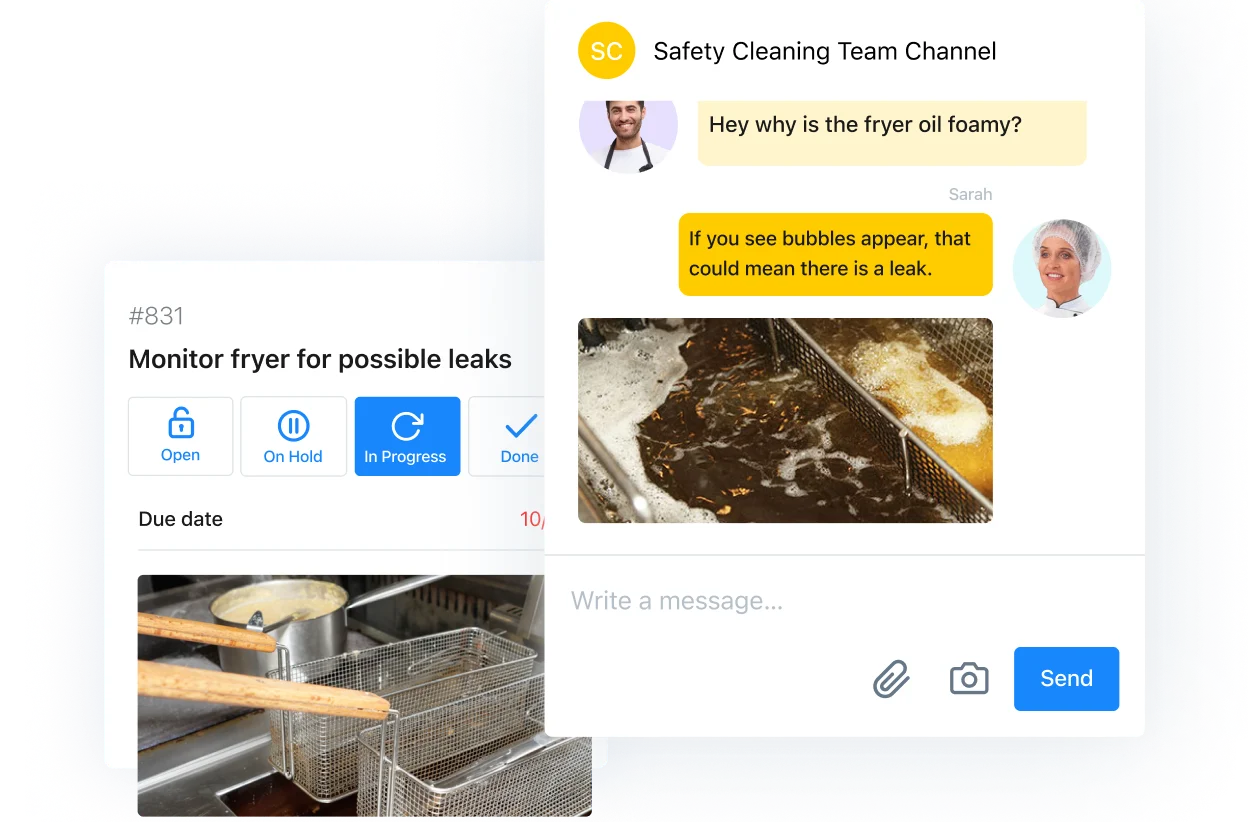
Ready to reduce the stress of standardizing the procedures necessary to succeed? Try MaintainX.




